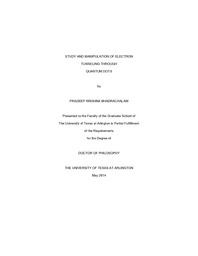
ATTENTION: The works hosted here are being migrated to a new repository that will consolidate resources, improve discoverability, and better show UTA's research impact on the global community. We will update authors as the migration progresses. Please see MavMatrix for more information.
Show simple item record
| dc.contributor.author | Bhadrachalam, Pradeep Krishna | en_US |
| dc.date.accessioned | 2014-07-14T20:22:16Z | |
| dc.date.available | 2014-07-14T20:22:16Z | |
| dc.date.issued | 2014-07-14 | |
| dc.date.submitted | January 2014 | en_US |
| dc.identifier.other | DISS-12589 | en_US |
| dc.identifier.uri | http://hdl.handle.net/10106/24406 | |
| dc.description.abstract | Fermi-Dirac distribution is the fundamental property which governs the electron energy distribution in solids. At finite temperatures, Fermi-Dirac thermal smearing of electron energies limits the operation of many electronic, opto-electronic and spintronic devices. Examples include single electron transistors, quantum dot resonant tunnel diodes for single photon detection, and single electron turnstile devices. To overcome this intrinsic limitation of Fermi-Dirac thermal smearing, these devices have typically been operated at cryogenic temperatures. Room temperature operation of these devices could be realized, however, if the thermal smearing of electron energies could be suppressed. Until now, studies in the fields of electron-tunneling refrigerators and double quantum dot devices have demonstrated limited manipulation/suppression of electron energy distribution, but those have been carried out at cryogenic temperatures. Using a double barrier tunneling junction structure as a model system this research has accomplished the following: * Demonstrated suppression of thermal smearing of electrons at room temperature, without any physical cooling of the system* Demonstrated that cold electrons whose effective temperature as low as ~45 K can be created at room temperature without any physical cooling* Systematically investigated the phenomenon responsible for suppression in thermal smearing of electron energies* Systematically investigated the cold electron transport in the double barrier tunnel junction structureOne of the key achievements of this research was demonstration of effective electron temperature of ~45K at room temperature without any physical cooling of the system. This was realized by filtering out the thermally excited electrons in a double barrier tunneling junction structure. A discrete energy state of a quantum well, created by band bending of Cr2O3 conduction band, acted as an electron energy filter, effectively suppressing energy distribution of electrons, thereby creating cold electrons (~45K) at room temperature. This phenomenon of electron energy filtering was observed in double barrier tunnel junction devices fabricated using different quantum dots (~5.5nm, ~6.6nm, ~7nm CdSe and ~7.8nm CdTe). The full width half maximum peak widths of differential conductance measurements of these devices, which is directly related to the Fermi-Dirac distribution of electrons, were found to be much narrower (~15meV at room temperature) than theoretically calculated values (~90meV at room temperature) as a result of suppression of Fermi-Dirac electron energy distribution.A model which takes electron energy filtering into account was used to numerically calculate the full width half maximum peak widths of differential conductance peaks at different temperatures (77K to 295K) and compared to the experimental results. The theoretical calculations are in very good agreement with the experimental results over the entire temperature range explored.Precise placement of quantum dots between the electrodes is one of the major challenges which need to be addressed for a large-scale fabrication of the devices investigated in this study. A nanoparticle placement technique, which is capable of precisely placing single nanoparticles onto desired substrate locations over an entire wafer, was demonstrated. Using this nanoparticle placement technique as a base model, a concept for guided placement of quantum dots/nanoparticles onto the double barrier tunneling junction device structure is presented. | en_US |
| dc.description.sponsorship | Koh, Seong Jin | en_US |
| dc.language.iso | en | en_US |
| dc.publisher | Materials Science & Engineering | en_US |
| dc.title | Study And Manipulation Of Electron Tunneling Through Quantum Dots | en_US |
| dc.type | Ph.D. | en_US |
| dc.contributor.committeeChair | Koh, Seong Jin | en_US |
| dc.degree.department | Materials Science & Engineering | en_US |
| dc.degree.discipline | Materials Science & Engineering | en_US |
| dc.degree.grantor | University of Texas at Arlington | en_US |
| dc.degree.level | doctoral | en_US |
| dc.degree.name | Ph.D. | en_US |
Files in this item
- Name:
- Bhadrachalam_uta_2502D_12589.pdf
- Size:
- 9.343Mb
- Format:
- PDF
This item appears in the following Collection(s)
Show simple item record


